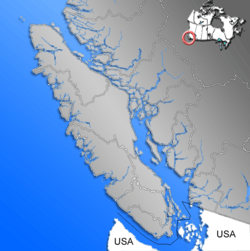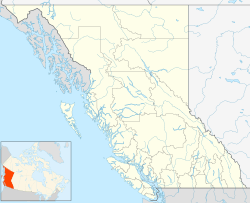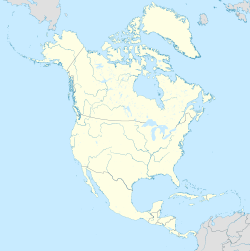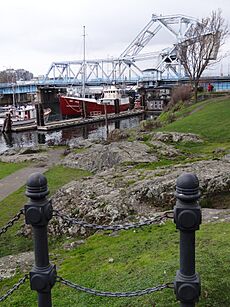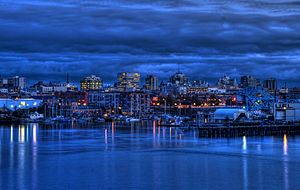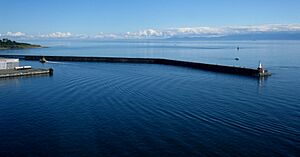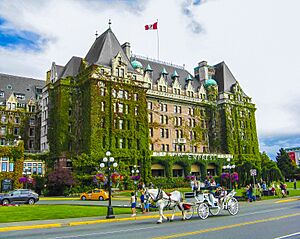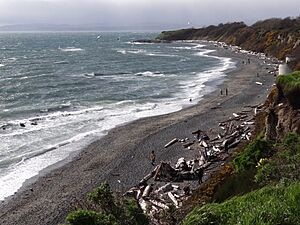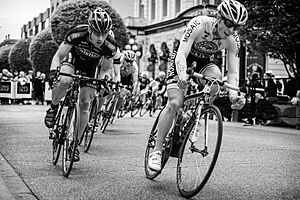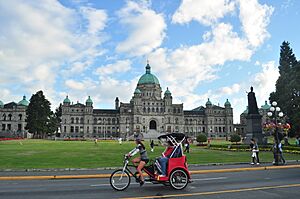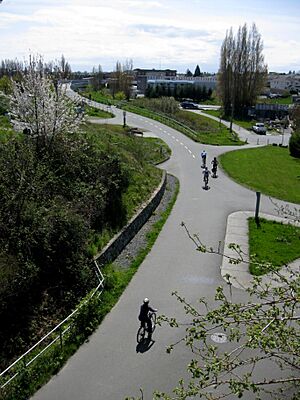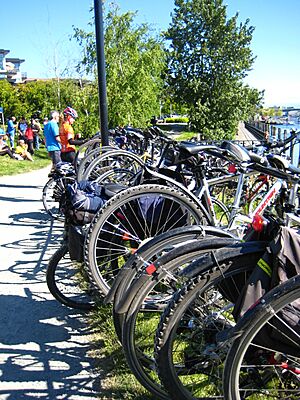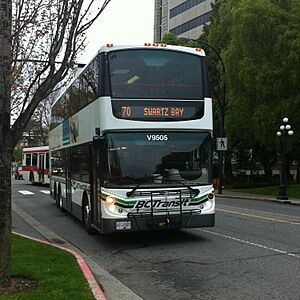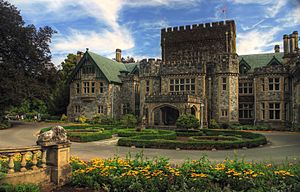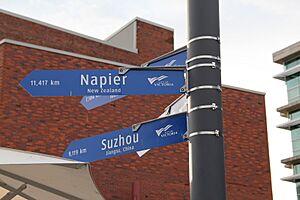Victoria, British Columbia facts for kids
Quick facts for kids
Victoria
|
|||||
|---|---|---|---|---|---|
| The Corporation of the City of Victoria | |||||
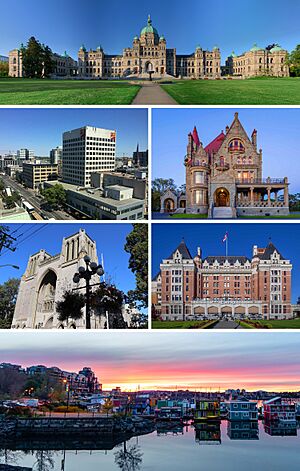
From the top, left to right: the British Columbia Parliament Buildings; Downtown Victoria; Craigdarroch Castle; Christ Church Cathedral; the Empress Hotel; and the Float Home Village at Fisherman's Wharf
|
|||||
|
|||||
| Nickname(s):
"The Garden City"
|
|||||
| Motto(s):
Semper Liber (Latin)
"Forever free" |
|||||
| Country | Canada | ||||
| Province | British Columbia | ||||
| Regional district | Capital Regional District | ||||
| Historic colonies | C. of Vancouver Island (1848–66) C. of British Columbia (1866–71) |
||||
| Incorporated | 2 August 1862 | ||||
| Named for | Queen Victoria | ||||
| Seat | Victoria City Hall | ||||
| Government | |||||
| • Type | Elected city council | ||||
| • Body | Victoria City Council | ||||
| Area | |||||
| • City | 19.47 km2 (7.52 sq mi) | ||||
| • Urban | 215.88 km2 (83.35 sq mi) | ||||
| • Metro | 696.15 km2 (268.79 sq mi) | ||||
| Elevation | 23 m (75 ft) | ||||
| Population
(2021)
|
|||||
| • City | 91,867 | ||||
| • Rank | 66th in Canada | ||||
| • Density | 4,722.3/km2 (12,231/sq mi) | ||||
| • Density rank | 7th in Canada | ||||
| • Urban | 397,237 | ||||
| • Urban density | 1,555.0/km2 (4,027/sq mi) | ||||
| • Metro | 397,237 (16th in Canada) | ||||
| • Metro density | 571.3/km2 (1,480/sq mi) | ||||
| Demonym(s) | Victorian | ||||
| Time zone | UTC–08:00 (PST) | ||||
| • Summer (DST) | UTC−07:00 (PDT) | ||||
| Forward sortation area |
V8N – V9E
|
||||
| Area codes | 250, 778, 236, 672 | ||||
| NTS Map | 92B6 Victoria | ||||
| GNBC Code | JBOBQ | ||||
| GDP (Victoria CMA) | CA$22.5 billion (2020) | ||||
| GDP per capita (Victoria CMA) | $53,446 (2016) | ||||
Victoria is the capital city of British Columbia, a Canadian province. It's located on the southern tip of Vancouver Island, right off Canada's Pacific coast.
The city itself has about 91,867 people. The larger Greater Victoria area is home to about 397,237 people. Victoria is one of the most crowded cities in Canada, with many people living close together.
Victoria is the most southern major city in Western Canada. It's about 100 kilometers (62 miles) southwest of Vancouver, British Columbia's biggest city, which is on the mainland. You can also reach Seattle by plane, seaplane, or ferry, which is also about 100 kilometers (62 miles) away. Port Angeles, Washington, is even closer, just 40 kilometers (25 miles) by ferry across the Strait of Juan de Fuca.
The city is named after Queen Victoria. It's one of the oldest cities in the Pacific Northwest, with British settlers arriving in 1843. Victoria has kept many of its old buildings. Two famous ones are the Parliament Buildings, finished in 1897, and the Empress Hotel, which opened in 1908. Victoria's Chinatown is the second oldest in North America, after San Francisco's. Long before Europeans arrived, Coast Salish First Nations peoples had large communities in this area.
Victoria is known as "the Garden City" because it's so beautiful. It's a popular place for tourists to visit. The city also has a growing technology industry, which is now its biggest private business. In 2019, Victoria was ranked among the top 20 cities in the world for its great quality of life.
Contents
Victoria's History
Before European explorers came in the late 1700s, the Greater Victoria area was home to several Coast Salish peoples, including the Lək̓ʷəŋən (Lekwungen) and W̱SÁNEĆ (Saanich) groups.
Early European Exploration (1770–1871)
Spanish and British explorers started mapping the northwest coast. Juan Pérez visited in 1774, and James Cook in 1778. Spanish sailors explored Esquimalt Harbour, just west of Victoria, in the early 1790s.
In 1841, James Douglas was asked to set up a trading post on Vancouver Island. He founded Fort Victoria in 1843. This was done in case Fort Vancouver fell into American hands after the Oregon Treaty of 1846.

Fort Victoria was built as a Hudson's Bay Company trading post. It was first called "Camosack," meaning "rush of water." It was briefly named "Fort Albert" before being renamed Fort Victoria in November 1843, honoring Queen Victoria. The Songhees First Nation had a village across the harbor from the fort. This village later moved north of Esquimalt in 1911.
Vancouver Island became a colony in 1849. Between 1850 and 1854, agreements called the Douglas Treaties were made with Indigenous communities to buy land. This helped the town grow and become the capital of the colony. However, there have been arguments about how fair these agreements were. James Douglas, who ran the fort, became the second governor of the Vancouver Island Colony. He played a big role in the city's early growth until he retired in 1864.
When gold was found on the British Columbia mainland in 1858, during the Fraser Canyon Gold Rush, Victoria became a busy port. It was a supply base for miners heading to the gold fields. Its population quickly grew from 300 to over 5,000 in just a few days. Victoria officially became a city in 1862. In 1865, the Royal Navy set up its North Pacific base in Esquimalt. Today, this is Canada's Pacific coast naval base.
In 1866, Vancouver Island joined with the mainland. Victoria was chosen as the capital of the new united colony, instead of New Westminster. This was not a popular decision on the mainland. Victoria then became the provincial capital when British Columbia joined Canadian Confederation in 1871.
Modern History (1871–Present)


In 1886, the Canadian Pacific Railway was completed, ending in Burrard Inlet. This meant Victoria lost its place as British Columbia's main business center to Vancouver. After this, Victoria started to focus on its beautiful natural setting and polite atmosphere. Famous visitors like Rudyard Kipling helped spread this image. The popular Butchart Gardens opened in 1904, and the Empress Hotel was built by the Canadian Pacific Railway in 1908.
Robert Dunsmuir, a rich industrialist who owned coal mines and a railway, built Craigdarroch Castle in the Rockland area. This was near the official home of the province's Lieutenant Governor. His son, James Dunsmuir, later became the Premier and then Lieutenant Governor of British Columbia. He built his own large home at Hatley Park, which is now Royal Roads University.
A building boom happened just before World War I. This left Victoria with many beautiful Edwardian buildings for public use, businesses, and homes. These buildings still add a lot to the city's unique look. During this time, several areas around Victoria became their own municipalities, like Esquimalt and Oak Bay.
Since World War II, the Victoria area has grown steadily. It is now home to two major universities. In the 1980s, western suburbs like Colwood and Langford became new municipalities. These are known as the Western Communities.
Sometimes, people in Greater Victoria talk about joining the thirteen local governments into one. Those against it say that separate governments give people more local control. Those for it argue that it would save money by avoiding duplicated services. They also say it would help with bigger regional issues and long-term planning.
Victoria's Geography
Land and Landscape
Victoria's landscape was shaped by volcanoes and water. During the Pleistocene glaciation (Ice Age), thick ice covered the area. The weight of this ice pushed the land down below sea level. As the glaciers melted, they left behind sand, gravel, and clay. When the ice was gone, the land rose, bringing beaches and mud deposits above sea level.
Because of this, Victoria's soils are very different from place to place. You might find clay in the northern parts and in low areas. The southern part has coarse soil underneath and rich topsoil. Sandy soils are common in the eastern part near Oak Bay. Victoria's soils are very fertile, meaning they were great for farming before the city grew.
Victoria's Climate
Victoria has a mild climate, often called a "warm-summer Mediterranean" or "oceanic climate." This means it has cool, cloudy, and rainy winters, but fresh, dry, and sunny summers.
Even though Victoria is farther north than many "cold-winter" cities like Ottawa, its winter temperatures are much higher. This is because of the westerly winds and warm Pacific Ocean currents. The average temperature in January is around 5.0°C (41°F).
In Victoria, temperatures usually go above 30°C (86°F) less than once a year. They fall below 0°C (32°F) only about ten nights a year. Some winters have had almost no snow. The highest temperature ever recorded was 39.8°C (103.6°F) in June 2021. The coldest was -15.6°C (3.9°F) in December 1941.
Victoria is one of the driest places on the British Columbia coast. This is because of the "rain shadow" effect from the nearby Olympic Mountains. The city gets about 608 to 661 millimeters (24 to 26 inches) of rain each year. For comparison, Vancouver gets much more rain, about 1589 millimeters (62.5 inches) annually.
Victoria has clear dry and rainy seasons. More than 60% of the yearly rain falls between November and February. December is the wettest month, while July is the driest. Victoria has the driest summers in Canada, except for the far northern areas.
Victoria gets about 26 centimeters (10 inches) of snow each year, which is half of what Vancouver gets. When it does snow, it usually doesn't stay on the ground for long. Every few decades, Victoria gets a lot of snow, like the record 100 centimeters (39 inches) in December 1996.
With 2,193 hours of sunshine each year, Victoria is one of the sunniest cities in British Columbia. In July 2013, Victoria had the most sunshine ever recorded in any month in BC history.
Victoria's mild climate has earned it the nickname "City of Gardens." Many flowers bloom during winter and early spring, including crocuses, daffodils, and cherry trees. Every March, the annual Greater Victoria Flower Count begins, while most of the country is still in winter.
Because of its mild weather, Victoria and its surrounding areas are home to many rare native plants. These plants are found nowhere else in Canada. Examples include the Garry oak tree and the Pacific madrone, Canada's only broad-leaf evergreen tree. Many of these plants grow here at the northern edge of their natural range.
Victoria's People
In the 2021 Census, Victoria had a population of 91,867 people. This was a 7.1% increase from 2016. The city is known for having a large number of retired people. About 23.4% of the population in Victoria and its surrounding area are over 65 years old.
Diverse Backgrounds
Victoria is home to people from many different backgrounds. Most residents are of European descent. There are also significant communities of East Asian, Indigenous, Southeast Asian, South Asian, African, Middle Eastern, and Latin American people.
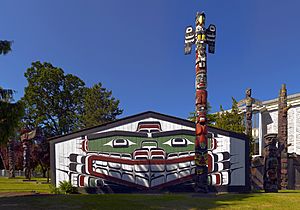
Beliefs and Spirituality
According to the 2021 census, most people in Victoria (63.4%) do not identify with a specific religion. Over 25% of residents are Christian. The next largest religious groups are Muslim (1.9%), Buddhist (1.4%), and Jewish (1.1%). Other groups like Hindu, Sikh, and Indigenous Spirituality make up smaller percentages.
Victoria's Neighbourhoods

The City of Victoria has several official neighbourhoods, as defined by its planning department. Some of these include:
- Burnside/Gorge
- Downtown
- Fairfield
- Fernwood
- James Bay
- Jubilee
- North Park
- Rockland
- Victoria West
There are also other well-known areas that people often call neighbourhoods, such as:
- Chinatown
- Rock Bay
- Songhees (part of Victoria West)
Helping the Homeless
In 2020, a count found at least 1,523 people experiencing homelessness in Victoria. This number is likely lower than the real total, as it doesn't include people who are "couch surfing" or staying in hidden places. Like many cities on the west coast of North America, homelessness is more visible in Victoria due to the mild climate.
The 2020 count showed that 35% of homeless people identified as Indigenous. This is much higher than the 4.7% of Indigenous people in Victoria's general population.
During the COVID-19 pandemic, many homeless people stayed in tents in city parks. In March 2021, the city council brought back a rule against daytime camping in parks. With help from the government, they worked to find indoor places for everyone camping in parks. Homeless campers were temporarily housed in motels, a sports arena, and a small "tiny home" village.
Victoria's Economy
Victoria's main industries are technology, tourism, education, shipyards, and government services. Other important employers include the Canadian Forces at CFB Esquimalt, the University of Victoria, and Camosun College. The economy also includes banking, online publishing, food making, and high-tech companies in areas like medicine and computers.
Jobs in Victoria
Most jobs in Victoria are in the service sector, with 87% of workers in this area. The biggest job areas include healthcare, public administration (government jobs), retail, and professional services. Construction and manufacturing are also important, but make up a smaller part of the job market.
Shopping in Victoria
Victoria has three main shopping malls: the Bay Centre, Hillside Shopping Centre, and Mayfair Shopping Centre. Mayfair was one of the first big shopping centers in Victoria, opening in 1963 with 27 stores. It has been updated and expanded several times since then. Today, Mayfair has over 100 stores and services.
Technology Industry
Technology is Victoria's biggest private industry, bringing in over $3.15 billion each year. More than 880 tech companies employ over 15,000 people. The total economic impact of this sector is over $4.03 billion per year. Victoria has many things that help its tech sector grow, including a high rate of internet use in homes. Over a hundred tech, software, and engineering companies have offices in Victoria.
Tourism in Victoria
Victoria is a very popular place for tourists. Over 3.5 million people visit overnight each year, adding more than a billion dollars to the local economy. Also, over 500,000 day visitors arrive by cruise ships at Ogden Point near the city's Inner Harbour. Many companies offer whale watching tours from this harbor because whales are often seen nearby. The city is also close to CFB Esquimalt, the Canadian Navy's main Pacific base.
Downtown Victoria is the main center for the whole Greater Victoria area. It has many night clubs, theaters, restaurants, and pubs. Many public events happen here, like Canada Day fireworks and music festivals. These events bring thousands of people to the downtown area.
Victoria has hosted big sports events, including the 1994 Commonwealth Games. It also co-hosted the 2007 FIFA U-20 World Cup at Royal Athletic Park. The city is a popular spot for meetings and conferences. Every year, the Swiftsure International Yacht Race brings boaters from around the world. The Victoria Dragon Boat Festival also attracts over 90 teams. The Tall Ships Festival brings large sailing ships to the city harbor.
The Port of Victoria has three parts: the Outer Harbour for large ships, and the Inner and Upper Harbours for smaller boats. It is protected by a breakwater. The port is a busy place for work, tourism, and cruise ships. Esquimalt Harbour is also a well-protected harbor with facilities for building and repairing ships.
Arts and Culture in Victoria
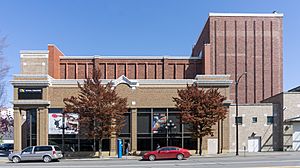
The Victoria Symphony performs at the Royal Theatre and the University of Victoria from September to May. Every BC Day weekend, the Symphony puts on "Symphony Splash." This is an outdoor concert where the orchestra plays on a barge in Victoria's Inner Harbour. Streets are closed, and about 40,000 people come to enjoy the music and events. The evening ends with Tchaikovsky's 1812 Overture, complete with cannon fire and fireworks.
Pacific Opera Victoria, Victoria Operatic Society, and Ballet Victoria also put on shows each year.
Theatre and Music
The Belfry Theatre started in 1974. It focuses on producing modern plays, especially new Canadian ones. Other local theater groups include the University of Victoria Phoenix Theatre and the Blue Bridge Repertory Theatre.
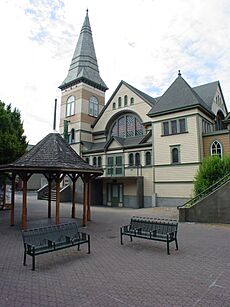
Victoria is home to the oldest continuously operating military band west of Thunder Bay, Ontario. The 5th (British Columbia) Field Regiment, Royal Canadian Artillery Band, started in 1864. They perform at military events and public concerts.
The annual Rifflandia Music Festival is one of Canada's largest modern rock and pop music festivals.
Movies Filmed in Victoria
Victoria is a popular place for filming movies and TV shows. This is partly because it's close to Vancouver and offers tax credits. Some movies filmed here include X2, White Chicks, and Final Destination. TV series like Smallville and The Dead Zone were also filmed in Victoria.
Famous Artists and Writers
Many talented people are from the Victoria area. Director Atom Egoyan grew up in nearby Saanich. Actors like Cameron Bright and Cory Monteith (from Glee) were born or raised here. Artist and jazz saxophonist Noah Becker is a long-time Victoria resident.
Nobel Prize winner Alice Munro lived in Victoria when she started publishing her stories. She also helped found Munro's Books. Other writers from Victoria include Esi Edugyan and Patrick Lane.
Musicians from Victoria
Several well-known musicians and bands are from the Victoria area. These include Nelly Furtado, David Foster, The Moffatts, and Hot Hot Heat.
Popular Attractions
In downtown Victoria, you can find the British Columbia Parliament Buildings, The Empress Hotel, and the Royal British Columbia Museum. The museum has large exhibits on local Aboriginal peoples, natural history, and modern history. Other downtown attractions include the Maritime Museum of British Columbia, Emily Carr House, and the Victoria Bug Zoo.
Canada's oldest Chinatown is also downtown. It includes the Chinese Public School built in 1909. The Art Gallery of Greater Victoria is near downtown, close to Craigdarroch Castle and Government House, the official home of the Lieutenant-Governor.
Many other historic buildings are in central Victoria. These include the 1845 St. Ann's Schoolhouse, the 1852 Helmcken House, and the 1863 Congregation Emanu-El, which is Canada's oldest synagogue still in use.
Downtown Victoria is great for walking. It has many crosswalks, pedestrian streets, and public squares. Fan Tan alley is the narrowest commercial street in North America, located in Chinatown. Waddington alley is unique because it's paved with wooden blocks.
Beacon Hill Park is the city's main urban green space. It's 75 hectares (185 acres) right next to Victoria's southern shore. The park has playing fields, beautiful gardens, exotic animals like peacocks, and a petting zoo. You can also see great views of the Strait of Juan de Fuca and the Olympic Mountains in Washington. The sport of cricket has been played here since the mid-1800s. Every summer, the city hosts concerts at the Cameron Band Shell in the park.
Victoria's parks also have rare natural Garry oak meadows. This ecosystem is becoming very scarce.
Private gardens that are open to the public include the rose garden next to the Empress Hotel, the Government House Gardens, and Abkahazi Garden.
Dallas Road is a waterfront trail and road that's 7.1 kilometers (4.4 miles) long. It's perfect for walking, running, biking, or driving. Clover Point is a main rest area along this road.
The David Foster Harbour Pathway is a walking path that goes around the inner harbor. It will be over 5 kilometers (3 miles) long when finished.
Attractions Outside the City
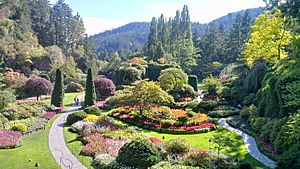
The CFB Esquimalt navy base, in the nearby town of Esquimalt, has a museum about naval and military history.
North of the city, on the Saanich Peninsula, you can find the Shaw Ocean Discovery Centre for marine biology. There's also Butchart Gardens in Brentwood Bay, which is a huge attraction. The Dominion Astrophysical Observatory, Victoria Butterfly Gardens, and the Centre of the Universe planetarium are also in this area.
Sports and Fun in Victoria
Victoria's climate, location, and many facilities make it great for outdoor activities. These include rock climbing, hiking, kayaking, golf, water sports, and jogging.
Victoria is known as the Cycling Capital of Canada. It has hundreds of kilometers of bike paths and lanes, including the Galloping Goose Regional Trail. There are also mountain biking trails at Mount Work Regional Park. Victoria is quickly becoming a popular place for bike tourism. Groups like the Greater Victoria Cycling Coalition work to make cycling even better in the city.
The Greater Victoria area has a rich history in motorsports. It was home to Western Speedway in Langford, the oldest speedway in western Canada. It hosted stock car racing, drag racing, and demolition derbies.
The area is also a headquarters for Rugby Canada and Rowing Canada. The Greater Victoria Sports Hall of Fame is at the Save-on-Foods Memorial Centre.
The Save-On-Foods Memorial Centre is the main sports and entertainment complex for Victoria. It's home to the Victoria Royals Western Hockey League (WHL) team.
Big Sports Events
Victoria has hosted many major international sports events. It co-hosted the 1994 Commonwealth Games and the 2005 Ford World Men's Curling Championship. Victoria was also one of the cities to host the 2007 FIFA U-20 World Cup. In 2010, Victoria was the first city for the 2010 Winter Olympics torch relay. Victoria also co-hosted the 2019 World Junior Ice Hockey Championships.
Victoria's Sports Teams

Victoria has been home to many famous sports teams. The Victoria Cougars were a well-known hockey team that won the Stanley Cup in 1925. Today, the Cougars name lives on with a junior hockey team. Minor professional hockey returned with the Victoria Salmon Kings from 2004 to 2011. In baseball, Victoria had the Victoria Athletics. The region's newest team is Pacific FC of the Canadian Premier League.
Many talented athletes from Victoria have played in professional sports or the Olympics. These include basketball Hall of Famer Steve Nash, who grew up in Victoria. Other notable athletes include NHL hockey players Jamie Benn and Jordie Benn, and Olympic medalists like Silken Laumann and Ryan Cochrane.
Here are some sports teams currently playing in Victoria:
| Club | Sport | League | Venue |
|---|---|---|---|
| Pacific FC | Soccer | Canadian Premier League | Starlight Stadium, Langford |
| Victoria Royals | Ice hockey | Western Hockey League | Save-On-Foods Memorial Centre |
| Victoria HarbourCats | Baseball | West Coast League | Royal Athletic Park |
| UVic Vikes | Various | U Sports | Various, principally UVic (Saanich-Oak Bay) |
| Camosun Chargers | Various | Canadian Colleges Athletic Association | Various, principally Camosun College (Saanich) |
| Victoria Shamrocks | Box lacrosse | Western Lacrosse Association | The Q Centre |
| Victoria Grizzlies | Ice hockey | British Columbia Hockey League | The Q Centre |
| Westshore Rebels | Canadian football | Canadian Junior Football League | Starlight Stadium, Langford |
| Victoria Highlanders | Soccer | USL League Two | Centennial Stadium |
| Eves of Destruction | Roller Derby | Women's Flat Track Derby Association | Various |
Victoria's Infrastructure

Victoria's water comes from the Sooke Lake Reservoir. The water is very clean and doesn't need much filtering. It's treated with chlorine, ammonia, and ultraviolet light to keep it safe.
The Hartland landfill in Saanich is where Greater Victoria's waste goes. It has a recycling center, hazardous waste collection, and a power plant that creates electricity from the landfill gas. This plant makes enough electricity for 1,600 homes.
Since December 2020, Victoria and nearby communities no longer dump untreated wastewater into the Strait of Juan de Fuca. A new wastewater treatment facility was built to clean the water before it's released.
Getting Around Victoria
By Air
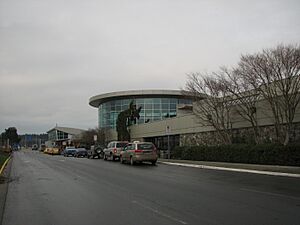
Victoria International Airport in North Saanich has direct flights to and from major Canadian cities like Toronto and Montreal, as well as Seattle. You can also take helicopter or seaplane flights daily from Victoria Inner Harbour Airport to Vancouver and Seattle.
Victoria is home to Harbour Air, the world's largest seaplane airline. They offer frequent flights between Victoria's inner harbor and Vancouver's downtown or airport. They also have scenic tour flights.
By Bicycle
Victoria's mild weather makes cycling a great way to get around all year. The Greater Victoria area has the highest rate of bicycle commuting in Canada. There's a growing system of bike lanes and paths, like the Galloping Goose Regional Trail and Lochside Regional Trail. These paths are for walkers, cyclists, and other small vehicles.
Victoria is building a 32-kilometer (20-mile) network of safe bike lanes for all ages and abilities. The first lane opened in 2017 on Pandora Avenue. More lanes have been added on streets like Fort Street, Wharf Street, and Vancouver Street.
"Go By Bike Week" is an event held twice a year to encourage cycling. It started in Victoria in 1995 and has grown across British Columbia. The event offers prizes, activities, and free workshops. "Celebration Stations" are set up around Victoria with snacks, coffee, and bike repair stands.
By Ferry
Several ferries connect Victoria to the Lower Mainland, Gulf Islands, and the United States. BC Ferries offers service between Swartz Bay (north of Victoria) and Tsawwassen on the mainland for cars, buses, and people. The Coho ferry carries cars and people between Victoria's inner harbor and Port Angeles, Washington. The Victoria Clipper is a ferry just for people and cyclists that runs daily between downtown Seattle and Victoria's inner harbor.
Public Transit
Local public transportation is run by the Victoria Regional Transit System. Since 2000, double-decker buses have been added to the bus fleet, becoming a symbol of the city. Most buses have bike racks on the front for two bicycles.
By Road
Victoria's roads are not set up in a simple grid. They wind around hills, parks, and coastlines, and often change names. This can make navigating a bit tricky.
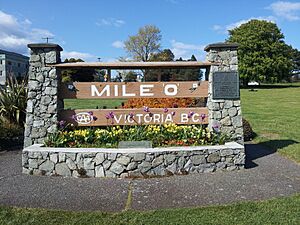
Victoria is the starting point (Mile Zero) for Canada's Trans-Canada Highway, the longest national highway in the world. The Mile Zero marker is at the very south end of Douglas Street, where it meets Dallas Road by the water. There's a statue there to honor Terry Fox.
Traffic delays during busy hours on the Trans-Canada Highway, especially to western suburbs like Langford and Colwood, are often called the "Colwood Crawl."
Other Ways to Travel
Coach bus service is available between downtown Victoria and downtown Vancouver or the Vancouver International Airport. These buses include the ferry fare and travel on the ferry. The trip usually takes under 4 hours.
Bus services from Victoria to other points on Vancouver Island are run by Island Link Bus or Tofino Bus. They depart from the Victoria bus terminal behind the Empress Hotel.
Education in Victoria
The city of Victoria is part of the Greater Victoria School District. Victoria High School is the only public high school within the city limits. It opened in 1876 and is one of the oldest high schools in North America. Many elementary schools offer both French and English programs.
There are also several private schools in the area, such as Glenlyon Norfolk School and St. Michaels University School.
Greater Victoria has three public colleges and universities:
- University of Victoria (UVic), with over 22,000 students. It's located in Saanich and Oak Bay.
- Camosun College, with over 20,000 students. It has two campuses in Saanich.
- Royal Roads University (RRU), with over 4,700 students. Its campus is in Colwood.
Several private career colleges are also in Victoria, including Pacific Rim College and Sprott Shaw College.
Media in Victoria
Victoria has several media outlets. The Times Colonist is an English-language daily newspaper. There are also local print publications, 12 radio stations, and 3 television stations: CHEK-DT, CIVI-DT (CTV 2), and Shaw Spotlight.
Victoria is the only provincial capital in Canada without its own local CBC Television station. However, it does have a small CBC Radio One station. The region mostly gets TV stations that broadcast from Vancouver.
Notable People from Victoria
- Tyson Barrie, hockey player
- Jamie Benn, hockey player
- Emily Carr, artist
- Sir Arthur Currie, general
- David Foster, music composer
- Nelly Furtado, singer and songwriter
- Ryder Hesjedal, road cyclist
- Cory Monteith, actor and musician
- Alice Munro, short story writer
- Steve Nash, basketball player
- Bill Reid, artist and carver
Sister Cities
Victoria has three "sister cities," which are cities that have a special partnership:
In March 2022, the Victoria City Council decided to pause its relationship with Khabarovsk, Russia. This was due to the 2022 conflict in Ukraine.
Victoria also has "Friendship City" agreements with:
Images for kids
See also
 In Spanish: Victoria (Columbia Británica) para niños
In Spanish: Victoria (Columbia Británica) para niños




